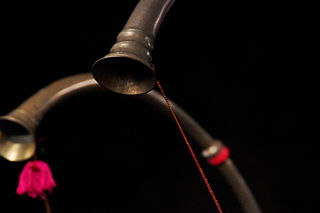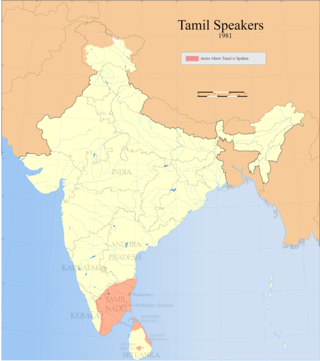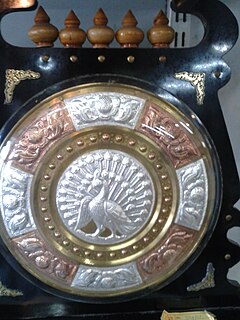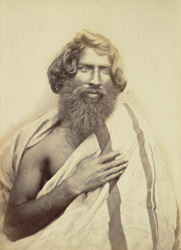 W
WAranjanam or Araijan Kayiru is a girdle-like ornament tied around the waist of infants and children. Also called 'Araijan Kodi'. It is made of gold, silver or thick thread. The primary purpose is to measure the healthy growth of an infant by the increase of the waistline. Aranjanam can also fasten the cloth on the waist, similar to women using it to secure the folds of a sari. It is possible that some parents also believe that it will safeguard against evil spirits. Although in India, most women and many men continue to wear them as adults as well.
 W
WThe Arulmiku Sivan Temple is a Hindu temple located in the municipality of Glattbrugg in the Canton of Zürich in Switzerland.
 W
WBharatanatyam, also previously called **Sadhir Attam,** is a major form of [Indian classical dance] that originated in [Tamil Nadu]. Bharatanatyam is one of the oldest classical dance traditions in India. It has been nurtured in the temples and courts of southern India since the ancient era. It is one of eight forms of dance recognized by the Sangeet Natak Akademi and it expresses South Indian religious themes and spiritual ideas, particularly of Shaivism, Vaishnavism and Shaktism.
 W
WA Boom Boom Ox is a decorated ox used in Tamil Nadu, India for fortune-telling by Boom Boom Mattukaran tribe. These oxen are decorated with jewellery, bells and bright cloth and are led by fortune tellers to individual houses or places where people gather. The patron usually stands in front of the ox and the fortune teller. The fortune teller asks the ox questions in a sing-song voice about the future of the patron. The Ox is trained to nod yes or no for the questions and from its head nods, the fortune teller tells the fortune of the patron. The term "Boom Boom Ox" is also used an insult in Tamil to denote a yes man or a weak willed person.
 W
WChicago Tamil Sangam (CTS) was established in August 1969 and is the oldest Tamil sangam in USA. The organization was created with the objective of keeping the Tamil language, culture and its rich heritage an integral part in the daily lives of thousands of Tamils living in the Greater Chicago Area. Over the years, CTS has driven continually in establishing a community presence for Tamils by getting directly involved in literary, cultural, charitable and social activities.
 W
WIn Ayurveda, a dosha is one of three substances that are believed to be present in a person's body. Beginning with twentieth-century literature, there was an idea called "The Three-Dosha Theory". Authoritative Ayurvedic treatises describe how the quantity and quality of these three substances fluctuate in the body according to the seasons, time of day, diet, and several other factors. While Ayurvedic doshas are a similar concept to Latin Humorism, it is a distinct system.
 W
WThe Kalaimamani is an highest civilian award of the Tamil Nadu state, India. These awards are given by the Tamil Nadu Iyal Isai Nataka Mandram for excellence in the field of art and literature.
 W
WKolam, also known as Muggu is a form of drawing that is drawn by using rice flour, chalk, chalk powder or rock powder, often using naturally or synthetically colored powders. It originated in Tamil Nadu and has since spread to the other Indian states of Karnataka, Telangana, Andhra Pradesh, and Kerala, and some parts of Goa and Maharashtra, as well as Indonesia, Malaysia, Thailand and a few other Asian countries. A Kolam is a geometrical line drawing composed of curved loops, drawn around a grid pattern of dots. In South India and Sri Lanka, it is widely practised by female family members in front of their houses. Kolams are regionally known by different names in India, Raangolee in Maharashtra, Aripan in Mithila, Hase and Rangoli in Kannada in Karnataka. More complex Kolams are drawn and colors are often added during holiday occasions and special events.
 W
WThe Kombu (Tamil:கொம்பு) or Kompu also known as the Kombu Pattu is a wind instrument in Tamil nadu and Kerala. Usually played along with Panchavadyam, Pandi Melam, Panchari melam etc. This musical instrument is usually seen in south India. The instrument is like a long horn.
 W
WKoothambalam or Kuttampalam meaning temple theatre is a closed hall for staging Koothu, Nangiar koothu and Koodiyattam, the ancient ritualistic art forms of Kerala, India. Koothambalams are said to be constructed according to the guide lines given in the chapter 2 of Nātyasāstra of Bharata Muni. The stage within the hall is considered to be as sacred as the temple sanctum. It is constructed within the cloister of the Temple; more precisely within the pancaprakaras of the temple. The prescribe location is between the prakaras of bahyahara and maryada. In Kerala tradition it is considered as one among the pancaprasadas of a temple complex. Its dimension vary from temple to temple. A square platform with a separate pyramidal roof supported by pillars in the center called natyamandapam is constructed as s separate structure within the large hall of Koothampalam. The floor of the hall is divided into two equal halves and one part is for performance and other half for seating audience. During the performance, the stage is decorated with fruit-bearing plantains, bunches of coconuts and fronds of the coconut palm. A para filled with rice is placed on the stage. A nilavilakku with three thiri is used for lighting. The mizhavu, a percussion instrument for accompanying Koothu, is placed within a railed enclosure, with a high seat for the drummer( belonging to nampiar community).
 W
WKoothu or Therukoothu (jwalith)(Tamil: கூத்து), is an ancient art, where artists play songs with dance and music in storytelling the epics, performed in Tamil; it is a folk art originated from the early Tamil country. More precisely Koothu refers to either Terukuttu (Tamil:தெருக்கூத்து) or Kattaikkuttu. The terms Terukkuttu and Kattaikkuttu are often used interchangeably in modern times; however, historically, the two terms appear to have distinguished, at least in certain villages, between two different kinds of performance: while Terukkuttu referred to mobile performances in a procession, Kattaikkuttu denotes overnight, narrative performances at a fixed performance space. Koothu as a form of entertainment reached its peak hundreds of years ago in Tamil Nadu, as mentioned in the Sangam texts about the development of iyal (literature), isai (music) and natagam (drama). Going beyond just a means of entertainment, koothu educates the rural people about religion and their history.
 W
WKuberakolam is a certain magic square of order three constructed using rice flour and drawn on the floors of several houses in South India. In Hindu mythology, Kubera is the god of riches and wealth, and it is believed that if one worships the Kubera kolam as ordained in the scriptures, he/she will be rewarded with wealth and prosperity. A kolam is a drawing composed of lines and loops, drawn around a grid pattern of dots. In many places in South India, this form of painting is drawn using rice powder /chalk/chalk powder and colored powders.
 W
WA langa voni is a traditional dress worn mainly in South India by young girls between puberty and marriage. It is also known as the two-piece sari or half sari. Young girls between puberty and marriage wear this dress. Girls younger than this may wear it on special occasions.
 W
WMarapachi Dolls, also known as Marapachi Bommais, are traditional dolls made specifically of red sandalwood or silk-cotton-wood (Bombax) or red wood (Sequoioideae) which are displayed during the Golu festival in South India as part of Dassara or Navaratri celebrations. These dolls made in pairs generally of male and female are dressed up by children as part of plaything and displayed during the Golu or "Bommai Kolu" festival. Tirupathi is one of the locations where it is specially ornamentally carved, and the dolls are stated to represent Venkateshwara and his consort. They are also made in Kondapalli as Raja-Rani dolls which are a compulsory display during the Golu festival.
 W
WThe murasu is a type of drum that originated in Tamil Nadu, India several centuries ago.
 W
WThis article is about the number words of the Tamil language, as well as the dedicated symbols for them used in the Tamil script.
 W
WPaambadam is an earring worn by elderly women in South Indian States such as Tamil Nadu & Kerala.
 W
WPaisley or paisley pattern is an ornamental textile design using the boteh or buta, a teardrop-shaped motif with a curved upper end. Of Persian origin, paisley designs became popular in the West in the 18th and 19th centuries, following imports of post–Mughal Empire versions of the design from India, especially in the form of Kashmir shawls, and were then replicated locally.
 W
WPambu Panchangam is the name of a Tamil Calendar published by Manonmani Vilasam Press in Chennai since 1883. The publisher's title for the almanac for the Tamil year 2012-2013 is Asal No. 28, Nandana Varsha Suddha Vakya Panchangam. The almanac is popularly referred to as the Pambu Panchangam because the cover page of the almanac carries a prominent image of a snake. The snake referred to here is the Moon in the Panchangam. The image of the snake contains 27 small circles embedded with it. These circles represent the 27 days the Moon takes to complete one full cycle. The reason Moon is represented as a snake is that, due to the pull and push of various planets, its path is like the path left by a snake on sand.
 W
WThe parai is a frame drum about 35 centimeters in diameter. It consists of a shallow ring of wood, covered on one side with a stretched cow hide that is glued to the wooden frame. The preferred wood is neem wood although other types may be used. The shell is made up of three separate pieces of wood each in the shape of an arc. These pieces are held together by three metal plates. The parai is played with two sticks: one long, thin flat bamboo stick called 'Sindu/ Sundu Kuchi' and a short, thick stick called 'Adi Kucchi' that can be made from any variety of wood
 W
WParrot astrology or Parrot fortune-telling is a type of astrology popular among the Tamils of Tamil Nadu, Telugus in Andhra Pradesh, India and Singapore. It involves using green parakeets which are trained to pick up Tarot like fortune cards. The parakeets are trained specifically for this.
 W
WSiddha medicine is a traditional medicine originating in South India. It is one of the oldest systems of medicine in India. The Indian Medical Association regards Siddha medicine degrees as "fake" and Siddha therapies as quackery, posing a danger to national health due to absence of training in science-based medicine. Identifying fake medical practitioners without qualifications, the Supreme Court of India stated in 2018 that "unqualified, untrained quacks are posing a great risk to the entire society and playing with the lives of people without having the requisite training and education in the science from approved institutions".
 W
WThe silambu is an anklet worn and used in a variety of contexts on the Indian subcontinent.
 W
WSooranporu or Soorasamharam part of Skanda Sashti Vratham festival is a ritual folk performance that recreates the killing of Asuras by Lord Murugan. It is performed in Tamil Nadu, Sri Lanka and the district of Palakkad in Kerala at temples dedicated to Murugan. The Soorasamharam festival is also celebrated in Thiruvannur Subramanya Swami temple in Kozhikode District kerala for more than a century in the name Sooranpada. The 2020 date is 20 November.
 W
WThe Sri Sivasubramaniar Temple is a Hindu temple located in Adliswil in the Sihl Valley in the canton of Zürich, Switzerland.
 W
WTamil Heritage Foundation (THF) is a non-profit organization that collaborates with the British Library to collect, preserve and digitize documents of Tamil cultural heritage. Among activities around the world, the project activities are centered primarily in India, United Kingdom, Germany, Switzerland and South Korea.
 W
WTemple cars are chariots that are used to carry representations of Hindu gods. The car is usually used on festival days, when many people pull the cart.
 W
WThe Thanjavur Art Plate is an artifact which is exclusively made in Thanjavur, Tamil Nadu, India. It is a circular plate made as a gift item. It is a handicraft consisting of metals such as silver, bronze, and copper embossed with figures of gods and goddesses at its center. The artwork has been registered for protection under the Geographical indication of the Trade Related Intellectual Property Rights (TRIPS) agreement. It is listed at item 63 as "Thanjavur Art Plate" of the GI Act 1999 of the Government of India, with registration confirmed by the Controller General of Patents Designs and Trademarks. Only the size of the article is permitted to be different while other metal compositions and particularization have to remain the same as per GI approval.
 W
WThanjavur Chariot festival is a historical event associated with the Big Temple, Thanjavur, Tamil Nadu, India.
 W
WThoranam are hanging decorations in Tamil Nadu. Rooted in Tamil culture it got a history way back to the Sangam period. The main purpose it was used on those days, since no printed invitations, to differentiate whether it is a happy occasion or mourning for the people who visit that place. It is made up of tender coconut leaf blades and has two types.
 W
WTiruvarur Chariot festival [Tiruvarur Therottam in Tamil] is a historical event that still follows the same rituals and traditions associated with the Thyagaraja Swamy temple, Tiruvarur, in Tamil Nadu. The Lord Veethividangar (வீதிவிடங்கர்) now called as Thiyagarajaswami (Shiva) comes out of the massive ancient temple, with his consort Kondi (கொண்டி) (Parvathi) to bless the devotees who always comes to visit him in his abode, one of the world's biggest chariots. And this chariot was constructed by Kothanars and it is Asia's biggest chariot.
 W
WThe Toda Embroidery, also locally known as "pukhoor", is an art work among the Toda pastoral people of Nilgiris, in Tamil Nadu, made exclusively by their women. The embroidery, which has a fine finish, appears like a woven cloth but is made with use of red and black threads with a white cotton cloth background. Both sides of the embroidered fabric are usable and the Toda people are proud of this heritage. Both men and women adorn themselves with the embroidered cloaks and shawls.
 W
WVaddanam is a gold ornamental belt worn by South Indian women on special occasions.
 W
WValluvar year, also known as the Thiruvalluvar year, is an officially recognized Tamil calendar system for use in Tamil Nadu. It is calculated on the basis of the supposed year of birth of the Indian poet-philosopher Valluvar. When comparing it with the widely used Gregorian calendar, Thiruvalluvar year will have an additional 31 years. For instance, the year 2021 in Gregorian calendar way is 2052 in the Thiruvalluvar year.